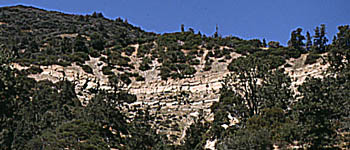BIOL 1400 -- Lecture Outline 10
"This world may be only illusion -- but it's the only illusion we've got."
--Edward Abbey
I. Life Through Time: Reading the Fossil Record
- How do we "read" the fossil record?
- Sedimentary rocks are found in layers -- like these, exposed in a cliff face:

Layers of sedimentary rocks near Ojai, California
- In 1669, a Danish bishop named Nicolaus Steno formulated what's
now known as the law of superposition:
- In any set of sedimentary rocks, the oldest rocks will be on the
bottom of the stack, and the youngest will be on the top.
- This may be altered if something has happened
to disturb the rocks after they are formed, such as bending, folding, or faulting.
But these leave traces; you can tell when they've happened.
- This has absolutely nothing to do with the absolute ages of the
rocks. A layer could be 100 million years older, or ten minutes older, than
the one above it.
- Nor is there any simple relationship between how thick a layer is and how
long it took to form.
- Nor does a stack of layered rocks have to be continuous -- there may be
periods of time during which no rocks formed.
- Steno (along with some other scientists) also showed clearly that fossils were in
fact the remains of once-living organisms. (This wasn't always obvious.)
- A British surveyor and canal-builder named William Smith noticed that different
rock layers contained different fossils. What's more, fossils appear in a definite
order, all over a large geographical region. This is the principle of succession.
(He published this discovery in 1815.)
- Simple example: At any place in the world where both dinosaur fossils
and whale fossils are found, the whale fossils are always in layers above the
ones where the dinosaur fossils are found.
- Other examples were in the slide show. . .
- At about the same time, the French scientist Georges Cuvier had made many
careful studies of fossils, and had conclusively shown that extinction was
real. Many species of organisms were no longer alive anywhere on Earth.
- What's more, the farther back in time you looked, the less familiar the fossils
looked.
- It was becoming increasingly clear that the Earth was much older than anyone
had suspected. (There had to be a lot of time to accommodate the growing number of
extinct organisms, and the great changes in biodiversity.) How old, no one was sure. . .
Go to Previous Notes |
Return to Lecture Schedule |
Return to Syllabus |
Contact the Prof |
Go to Next Notes
